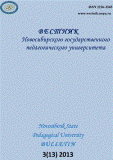ПРИМЕНЕНИЕ ЭЛЕМЕНТОВ КОЧЕВОЙ КУЛЬТУРЫ (ВОЙЛОКОВАЛЯНИЯ) В СЕНСОРНОМ РАЗВИТИИ ДЕТЕЙ С ЦЕРЕБРАЛЬНЫМ ПАРАЛИЧОМ
USING ELEMENTS OF THE NOMADIC CULTURE (VOYLOKOVALYANIYA) IN THE SENSORY DEVELOPMENT OF CHILDREN WITH CEREBRAL PALSY
Author(s): Bakitzhamal Bakustarovna Gabdulhaeva, Lyailya Vahitovna Reznik, Aigul Salimzhanovna Dinmuhamedova , Saltanat Zhumabaevna Kabieva, Gulsara Kanatovna DarzumanSubject(s): Cultural history
Published by: Новосибирский государственный педагогический университет
Keywords: voylokovalyanie; sensory development in children; fine motor skills; tactile sensitivity; stimulation of creativity; national culture; national craft.
Summary/Abstract: The article discusses the features of the remedial work with children with cerebral palsy. It is shown that the inclusion of content rehabilitation unit classes "Voylokovalyanie" leads to a general improvement in psychomotor development of children surveyed, in particular sensory development, which creates the necessary preconditions for the formation of mental functions, kinesthetic, kinetic and other sensations. The block of training allows children to develop skills in a variety of instruments and appliances for the manufacture of products made of wool to form creativity in the process of creating an artistic image of the technique voylokovalyaniya, foster respect for the traditions of national culture and the work of craftsmen, hard work and perseverance.
Journal: Вестник Новосибирского государственного педагогического университета
- Issue Year: 2013
- Issue No: 3
- Page Range: 92-99
- Page Count: 8
- Language: Russian

